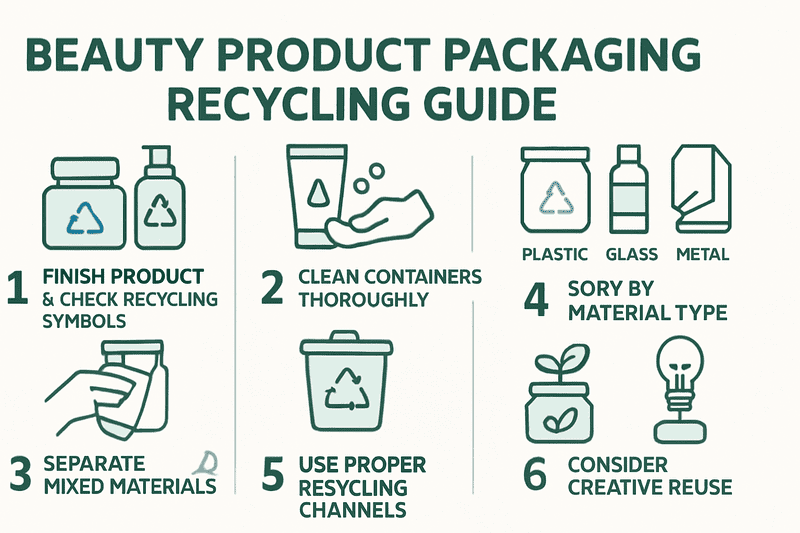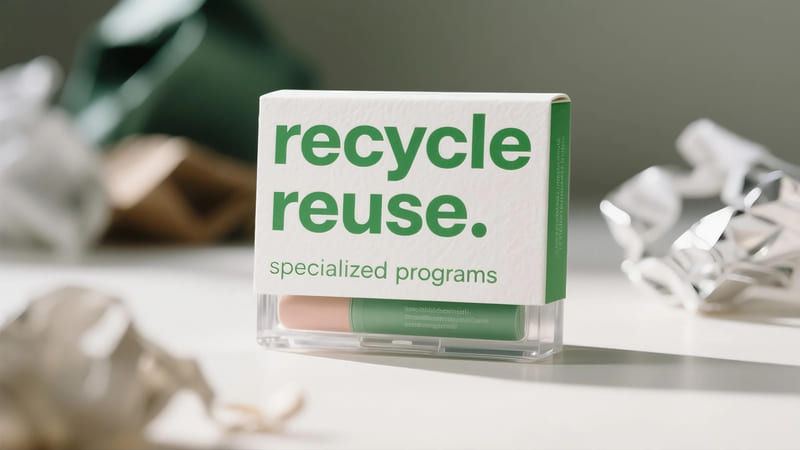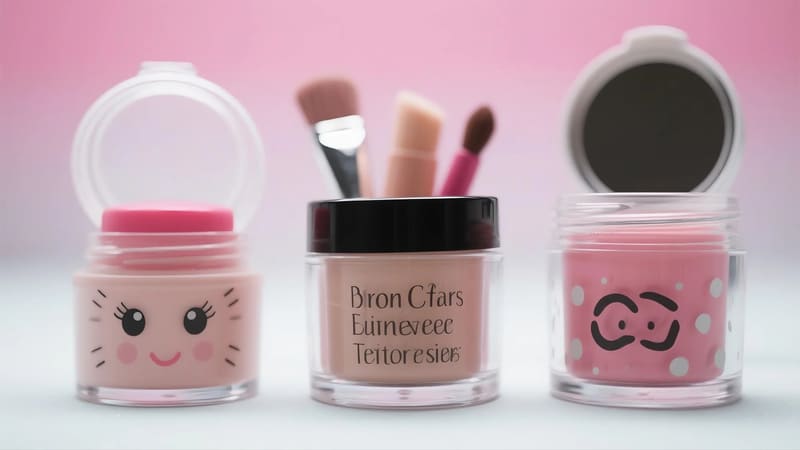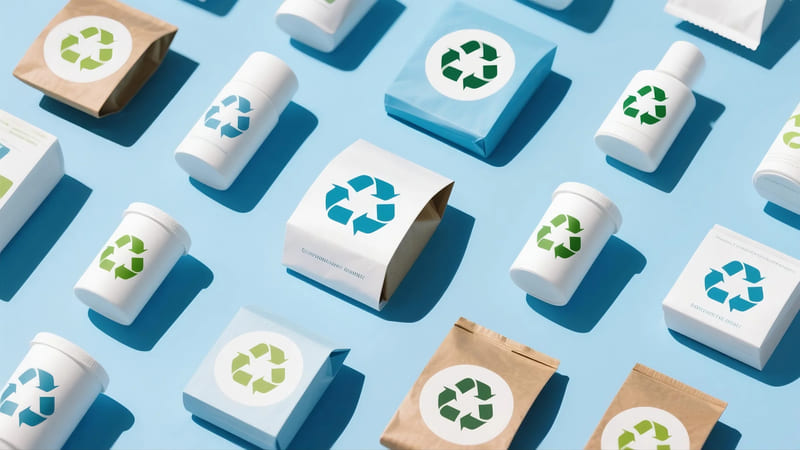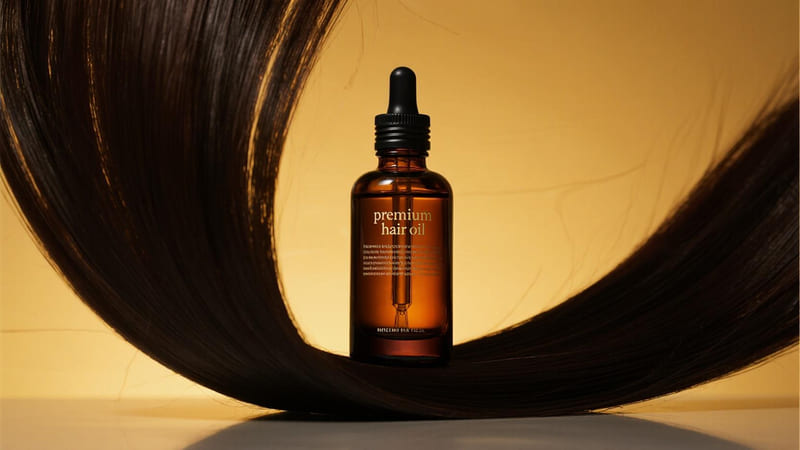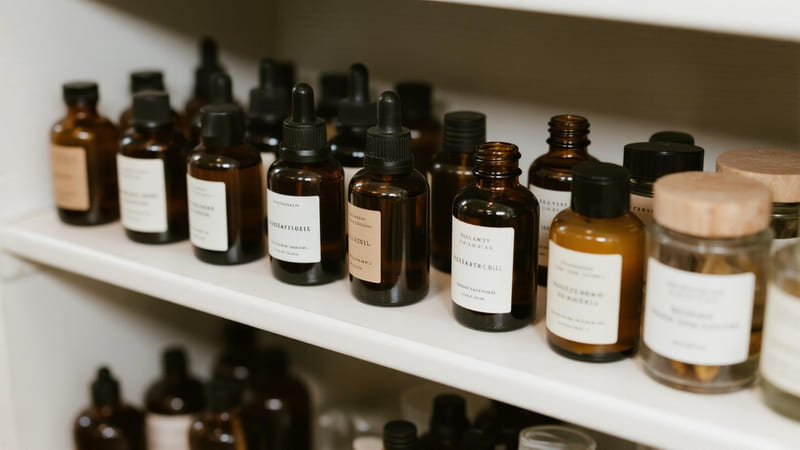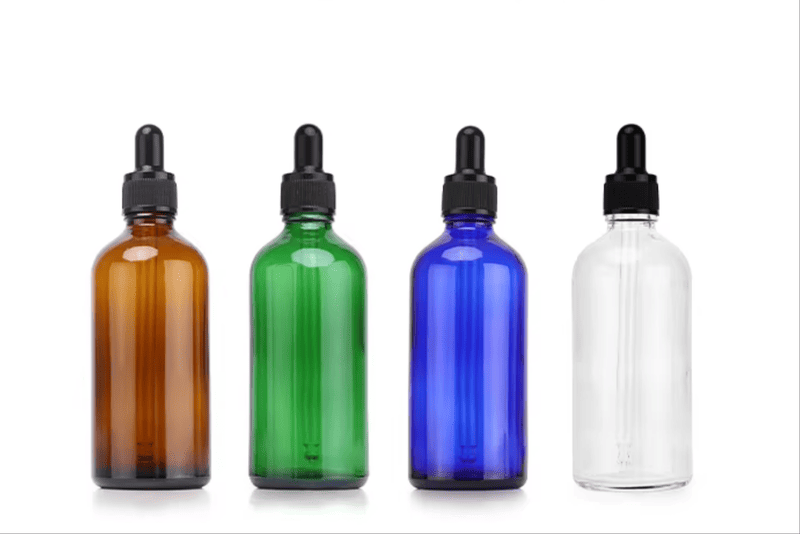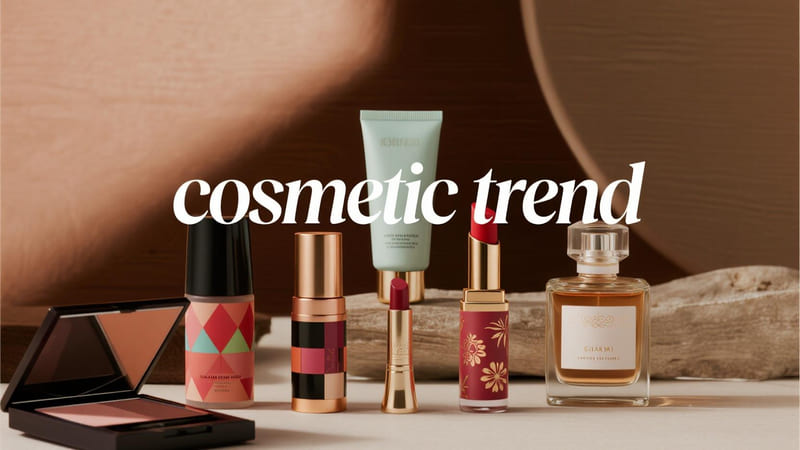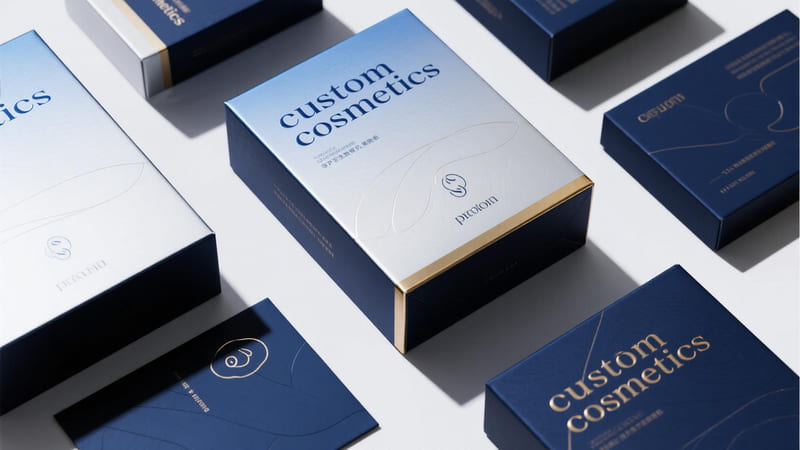Your favorite lipstick is finished, the eyeshadow pan is empty. Now what? Tossing that often intricate makeup packaging into the trash contributes to a massive waste problem. Learning how to recycle it properly is a small but impactful step.
To recycle makeup packaging, first clean it thoroughly. Check local recycling guidelines as acceptance varies. Disassemble components if possible (e.g., remove pumps, separate materials). Look for brand take-back programs (like MAC, TerraCycle partnerships) for hard-to-recycle items. Prioritize packaging made from easily recyclable mono-materials like PET plastic or glass.
The beauty industry generates a staggering amount of packaging waste each year. As a packaging manufacturer with ShineTop, we’re increasingly focused on sustainable solutions, but consumer action in recycling is also vital. Let’s break down how you can navigate the often-confusing world of makeup packaging recycling.
How to Recycle Beauty Product Packaging?
Recycling beauty product packaging, which includes skincare, haircare, and makeup, requires a bit more diligence than recycling everyday household items due to mixed materials and small components.
To recycle beauty product packaging: 1. Empty and clean containers thoroughly. 2. Check the recycling symbol (resin code) and your local municipal recycling rules. 3. Disassemble multi-material items if possible. 4. Utilize brand take-back programs or specialized recycling services like TerraCycle for items not accepted curbside.
A systematic approach can help ensure more of your beauty empties actually get recycled.
General Steps for Recycling Beauty Packaging:
-
Empty It Out:
- Make sure the product is completely used up. Cut open tubes to scrape out the last bits. For powders, remove as much residue as possible.
-
Clean It Thoroughly:
- Residue can contaminate the recycling stream. Rinse out bottles, jars, and tubes with soap and water. For oily products, a good wash is essential. Let them dry.
-
Check the Material & Recycling Symbol:
- Look for the chasing arrows symbol with a number inside (Resin Identification Code for plastics).
- #1 PET/PETE (e.g., some bottles): Widely recycled.
- #2 HDPE (e.g., some bottles, tubes): Widely recycled.
- #5 PP (e.g., some jars, caps, tubes): Increasingly recycled, but check locally.
- Glass (clear & colored): Widely recycled (remove non-glass lids).
- Aluminum (e.g., some tubes, aerosol cans – empty them!): Widely recycled.
- Mixed Materials: These are the trickiest (e.g., a pump with metal springs and multiple plastic types, compacts with mirrors and metal pans).
- Look for the chasing arrows symbol with a number inside (Resin Identification Code for plastics).
-
Consult Your Local Recycling Program:
- This is CRUCIAL. Recycling capabilities vary significantly by municipality. Check your local council’s website for what they accept in curbside bins.
- Size Matters: Many small items (like small caps, sample pots, or eyeshadow pans) can fall through sorting machinery and may not be accepted even if the material is recyclable. Some suggest collecting small plastic items in a larger container of the same plastic type (e.g., #5 PP caps inside a larger #5 PP tub), but always check if your local facility allows this.
-
Disassemble (If Possible & Safe):
- If a package is made of different materials that can be easily separated (e.g., a plastic cap from a glass bottle, a paper box from a plastic tube), do so. This increases the chances of each part being recycled correctly.
- Be cautious with items like pumps that have hidden metal springs – these are often best sent to specialized programs.
-
Utilize Specialized Recycling Programs:
- Brand Take-Back Schemes: Many beauty brands (e.g., MAC’s "Back to MAC," Kiehl’s, L’Occitane, The Body Shop) offer in-store recycling programs for their own packaging, sometimes with incentives.
- TerraCycle: This company partners with many brands to offer free recycling programs for hard-to-recycle beauty packaging (like flexible tubes, pumps, droppers, colored glass, and mixed-material items). You often collect items and mail them in using a free shipping label. Check their website for participating programs.
- Pact Collective: Another organization focused on hard-to-recycle beauty packaging, with drop-off locations and mail-in programs.
Anna, a cosmetics manufacturer in Thailand, is exploring how she can educate her customers on recycling the PCR plastic and glass packaging we supply her with, potentially partnering with a local initiative.
What to Do With Makeup Packaging?
Beyond just tossing it in a bin, there are several responsible and creative options for dealing with your used makeup packaging, aiming to minimize waste.
With makeup packaging, prioritize recycling through curbside programs where possible (after cleaning and checking local rules). For non-recyclable items, explore brand take-back programs or specialized services like TerraCycle. Alternatively, consider reusing or upcycling containers creatively.
The goal is to divert as much as possible from landfills. Here’s a hierarchy of what to do:
-
Reduce & Choose Wisely First:
- Opt for brands with minimal or sustainable packaging (refillable, PCR content, easily recyclable mono-materials).
- Buy larger sizes if you use a product frequently to reduce overall packaging.
- Consider solid alternatives (e.g., shampoo bars, solid cleanser) that use less packaging.
-
Clean & Recycle (Curbside):
- For items made of commonly accepted materials like clear PET bottles (#1), HDPE bottles (#2), glass jars/bottles, and clean aluminum tubes/cans.
- Always follow your local guidelines. "Wishcycling" (putting non-recyclable items in the bin hoping they’ll get recycled) can contaminate the entire batch.
-
Specialized Recycling Programs:
- Brand Programs: Take advantage of in-store drop-offs.
- TerraCycle / Pact Collective: Excellent for mixed materials, pumps, flexible tubes, droppers, makeup palettes, and other items your local service won’t take. This is often the best route for complex makeup packaging.
-
Reuse & Upcycle (See next section):
- Get creative and give containers a second life.
-
Proper Disposal (Last Resort):
- If an item is truly not recyclable through any available program and cannot be reused, dispose of it in the general waste. Ensure it’s clean to avoid attracting pests.
The key is to be an informed consumer. At ShineTop, we’re working on designing more mono-material packaging and clearly labeling materials to make the recycling decision easier for end-users.
How Do You Reuse Empty Makeup Containers?
Many makeup containers, especially those from higher-end brands, are beautifully designed and sturdy. Instead of discarding them, why not give them a new purpose around your home?
Empty makeup containers can be reused for storing small items (jewelry, pills, craft supplies), as travel containers for other cosmetics or toiletries, for DIY beauty projects (lip balm pots, solid perfume tins), or as decorative elements (mini vases, organizers).
Reusing containers is a fantastic way to reduce waste and get more value from the packaging.
Ideas for Reusing Empty Makeup Containers:
- Jars (Face Cream, Eye Cream):
- Store Q-tips, cotton balls, hair ties, bobby pins.
- Hold small office supplies: paper clips, thumbtacks.
- DIY lip scrubs, solid perfumes, or homemade balms.
- Travel containers for other creams or pills.
- Compacts (Powder, Blush, Eyeshadow):
- Clean out thoroughly and use as a pill case for your handbag.
- Store tiny earrings or rings when traveling.
- Refill with a DIY solid perfume or lip balm (if the pan can be removed and cleaned).
- Use the mirror for touch-ups.
- Lipstick/Lip Gloss Tubes:
- Clean well and store bobby pins, toothpicks, or emergency sewing needles.
- Some can be refilled with DIY lip balm.
- Mascara Tubes & Wands:
- Thoroughly clean the wand and use it as an eyebrow brush/spoolie or to separate lashes after applying new mascara.
- The clean tube (if possible to clean well) is harder to reuse due to its shape.
- Perfume Bottles (Glass):
- Mini bud vases.
- Reed diffusers (add oil and reeds).
- Decorative display items.
- Pump Bottles (Foundation, Serum):
- If they can be opened and cleaned thoroughly, they can be refilled with other lotions, soaps, or serums for travel.
- Tins (Lip Balm, Salve):
- Perfect for storing small craft supplies (beads, sequins), pills, solid perfume, or even spices for travel.
Cleaning Tip: For stubborn makeup residue, especially in plastics, try soaking in warm soapy water, using rubbing alcohol, or an oil-based cleanser (for oily makeup), then wash again. Ensure containers are completely dry before reusing.
Can Product Packaging Be Recycled?
This is a common question, and the answer is, unfortunately, "it depends." While many materials are recyclable in theory, practical recyclability varies greatly.
Yes, many types of product packaging can be recycled, including glass, aluminum, steel, many paper/cardboard types, and certain plastics (like #1 PET and #2 HDPE). However, actual recyclability depends on the specific material, local recycling infrastructure, contamination levels, and market demand for the recycled material.
The ability to recycle packaging is influenced by a complex interplay of factors.
Factors Affecting Packaging Recyclability:
-
Material Type:
- Highly Recyclable: Glass (clear and colored), aluminum, steel, clean paper and cardboard, #1 PET plastic, #2 HDPE plastic.
- Moderately Recyclable (Check Locally): #5 PP plastic.
- Difficult to Recycle (Often Not Accepted Curbside):
- Mixed materials (e.g., plastic bonded to foil, laminated paper).
- Small items (caps, small pots – can get lost in machinery).
- Flexible packaging (pouches, sachets – though some specialized programs exist).
- Black or very dark plastics (can be invisible to sorting sensors).
- Some #3 PVC, #4 LDPE (films often require store drop-off), #6 PS (polystyrene/Styrofoam), #7 Other (mixed plastics, bioplastics unless specifically compostable and facilities exist).
-
Local Recycling Infrastructure:
- What your specific town or city’s Material Recovery Facility (MRF) is equipped to handle is the biggest determinant. Always check their guidelines.
-
Contamination:
- Food or product residue can contaminate a whole batch of recyclables, rendering them unusable. This is why cleaning packaging is so important.
-
Market Demand:
- Recycling is a business. If there’s no market for a particular recycled material, it’s less likely to be processed even if collected.
-
Design of the Packaging:
- Mono-material packaging is much easier to recycle than items made of multiple materials fused together.
- Labels that are hard to remove or made of a different material than the container can be problematic.
As a packaging supplier, ShineTop is increasingly focused on designing for recyclability. This includes promoting mono-material solutions, using easily recyclable plastics like PET and PP, offering PCR content to support the market for recycled materials, and ensuring our glass and aluminum options are optimized for existing recycling streams. We also work with clients to ensure labeling is clear to help consumers make the right recycling choices.
Conclusion
Recycling makeup packaging requires a conscious effort: clean items thoroughly, understand your local recycling rules, and utilize specialized programs like TerraCycle or brand take-back schemes for hard-to-recycle components. Reusing containers creatively is another excellent way to reduce waste. By making informed choices as consumers and by brands designing more recyclable packaging, we can lessen the beauty industry’s environmental footprint.


